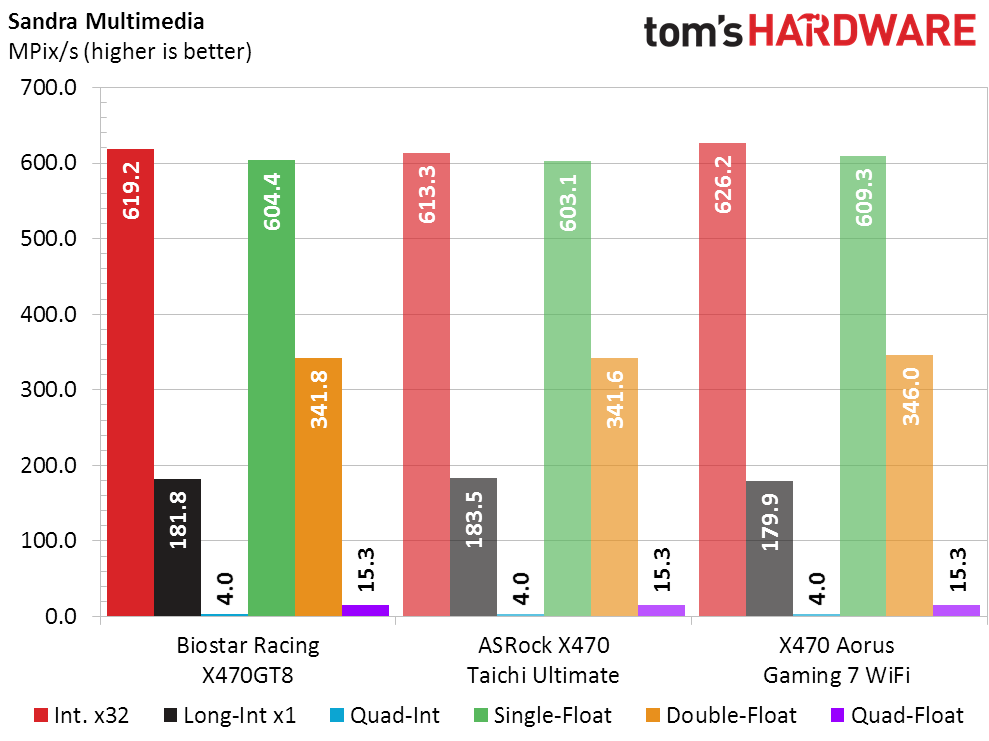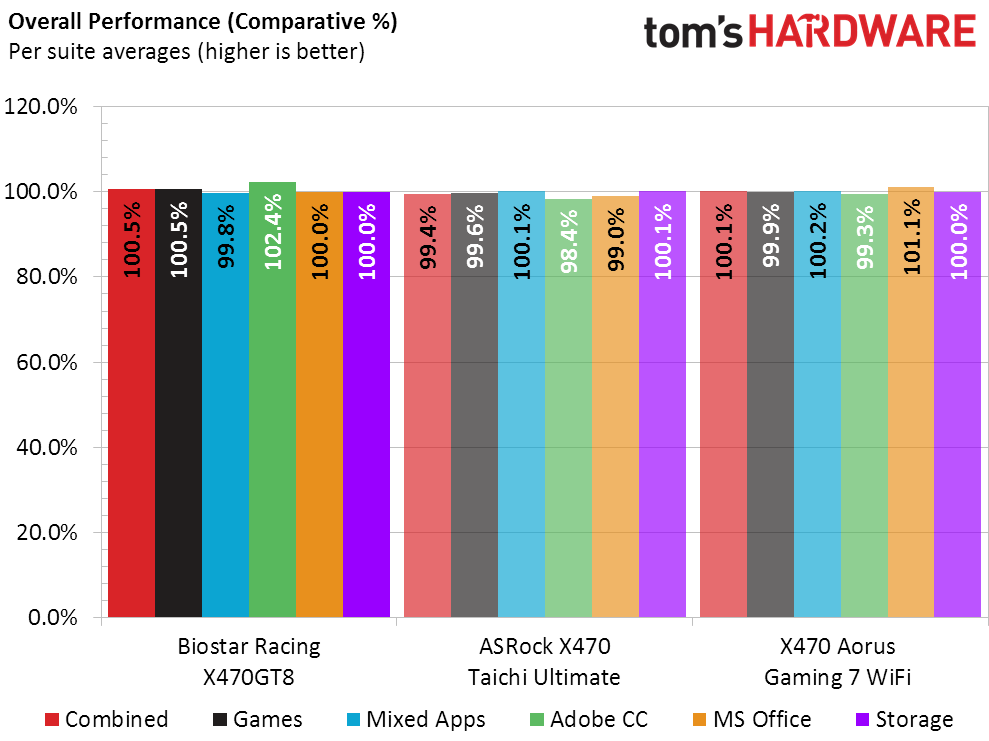Biostar Racing X470GT8 Review: Ryzen Higher For Less
Why you can trust Tom's Hardware
Benchmark Results & Final Analysis
Our benchmark and power measurements use DDR4-2400 DRAM defaults with all CPU-based power saving technologies enabled in firmware.
Synthetic Benchmarks
The Racing X470GT8 takes a slight lead in 3DMark scores across three tests, though it started out down a little in the graphics score of our lowest settings. Everything looks normal in PCMark, and even Sandra Memory Bandwidth is spot-on.










With no clear indication of performance differentiation in our longer Cinebench and Compubench tests, it’s time to see if any of these boards stands out in games.
3D Games
Though it lagged behind by a measly 1 FPS in our lowest F1 2015 test, the Racing X470GT8 appears to have an overall lead of approximately 1 FPS across the average of titles and settings.





Timed Applications
The Racing X470GT8 wins a couple of our shorter timed tests, and loses a few longer ones, as if its throttling back slightly over time. That doesn’t seem to affect Adobe After Effects results however, so maybe the other small differences occurred by happenstance?



Power, Heat, & Efficiency
The Racing X470GT8 throttled back a little more than its competitors under heavy CPU load, which had a greater impact on our power and heat measurements than on performance metrics, so we’re going to ask users to take the results with a grain of salt. The actual difference between it and the other boards was around 125MHz, which should be around 10W according to our observations, and we can’t get a more-precise number by which a true measure of efficiency would be possible.



Overclocking
The Racing X470GT8 had the greatest amount of voltage sag, resulting in the lowest full-load CPU core voltage, yet still held a higher stable frequency at 4.30GHz. Evidence of the lower voltage reported in software was affirmed in a power reading of around 260W at 4.3GHz full-load, rather than the approximate 267W of the boards that achieved only 4.25 and 4.27 GHz.
Get Tom's Hardware's best news and in-depth reviews, straight to your inbox.


DRAM overclocking was nearly impossible, and while retesting with faster-rated modules was an option, the modules we’re using are known to blow past DDR4-4000 on certain other motherboards.
Final Thoughts
Cheapskates love performance-per-dollar charts, because they typically show the board with the fewest features as having the best value. On the other hand, the more-expensive competitors do have a few features that we’d like to use.
For example, both competing boards here have dual M.2 storage slots. The hyper-expensive X470 Taichi Ultimate also includes 10Gb Ethernet, in addition to an identical Gigabit Ethernet controller and a low-end Wi-Fi controller. That sounds like a great configuration for builders who would like their most-powerful system to also be a media hub for their entire home. But the difference in price is quite excessive at $120. Heck, you could almost buy a second Racing X470GT8 for that price premium!
The Aorus Gaming 7 WiFi sits in the middle with a vastly superior Wi-Fi controller, but no 10Gb Ethernet. Gigabyte has the firmware and RGB control nailed down tight on that board, making it a great choice for people who are willing to pay for things done right. But from a features standpoint, it’s still hard to give that board the extra $75 credit it would need to keep up with the Racing X470GT8’s pricing value.
The modestly-priced Racing X470GT8 thus gets an extra point for value, and that puts it into award territory. As editor, I hate giving such a poor DRAM overclocking board an “Editor’s Choice”, but perhaps that’s only because I’m also a DRAM editor. But superior CPU overclocking at a price that easily undercuts the competition is enough to make this board a winner, even if it's not great at pushing memory to the highest possible clock speeds.
MORE: Best Motherboards
MORE: How To Choose A Motherboard
MORE: All Motherboard Content
-
Ratlle Thank you Mr. Soderstrom i'll wait for your Benchmark Results & Final Analysis.Seems like here you don't have the MSI control features .Reply -
logainofhades Price seems a bit high, with it lacking SLI support. If I were to build an ATX Ryzen build today, I would probably use an ASRock - X470 Master SLI/AC.Reply -
Rexer First build was a Biostar 12 yrs. ago. Didn't last 6 months so I haven't paid much attention to them. Replaced it with a Foxcon board. Doesn't sound like I'm a winner. I don't see any audio chips in usual places. How's the audio quality or did I miss something? Like to know what it would do with a superb sound card. Maybe feed it into a home audio pre-amp. Tired of coming home to good whiskey and crappy sound.Reply -
thrones.rush its not sheer resistance by the way.its shear resistance, as in how much force needed to shear it offReply -
Crashman Reply
It has the same ALC1220 as nearly anything it competes against. You can read more about the circuitry at the board's microsite, but I think Biostar would be better off if it hired you to write the dang thing :D21377924 said:First build was a Biostar 12 yrs. ago. Didn't last 6 months so I haven't paid much attention to them. Replaced it with a Foxcon board. Doesn't sound like I'm a winner. I don't see any audio chips in usual places. How's the audio quality or did I miss something? Like to know what it would do with a superb sound card. Maybe feed it into a home audio pre-amp. Tired of coming home to good whiskey and crappy sound.
-
Calculatron Unfortunate about the DRAM issues!Reply
I've been keeping an eye on Biostar for a while, now, since they've really upped their game and quality over the last couple years. When I rebuilt my rig around the X370 platform, it was a really hard choice between the Gigabyte Aorus K7 and Biostar GT7. I ended up going with the Gigabyte product, but only because I managed to catch an Amazon Warehouse deal. -
lpide Seems like a good deal, even with limited DRAM overclocking.Reply
Good to see them coming back as the other big brands seems to be getting worse in quality.

